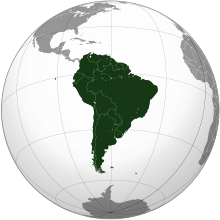‘2020’ Category
» posted on Tuesday, July 5th, 2022 by Linda Lou Burton
Readin’ and Writin’ and ‘Rithmatic
Originally Published July 8, 2020 by Linda Lou Burton posting from Little Rock, Arkansas – Do you know how many students attended public schools in the United States in the 2019-2020 school year? According to the National Center for Education Statistics, https://nces.ed.gov/fastfacts/, about 50.8 million – 35.5 million in prekindergarten to grade 8, and 15.3 million in grades 9-12.
 About 3.7 million students graduated from high school this spring, in the strangest ending to a school year anyone can recall. I’ve heard stories from my parents of “depression years” and school schedules revolving around “cotton-picking time.” My Dad was double-promoted in high school during hard times and wound up graduating at age 16. “Daddy had been a school teacher, and he made sure I got my studies done first. So I’d go to classes in the morning and then put in a crop in the afternoon,” he told.
About 3.7 million students graduated from high school this spring, in the strangest ending to a school year anyone can recall. I’ve heard stories from my parents of “depression years” and school schedules revolving around “cotton-picking time.” My Dad was double-promoted in high school during hard times and wound up graduating at age 16. “Daddy had been a school teacher, and he made sure I got my studies done first. So I’d go to classes in the morning and then put in a crop in the afternoon,” he told.  My Mom was dealt a reverse blow – her father held her back for two of her school years; once due to a lengthy illness and once when she simply needed to help support the family. My grandfather was a carpenter, and she dug clay from the riverbank to make bricks. But both parents persevered. They made it, despite the odds.
My Mom was dealt a reverse blow – her father held her back for two of her school years; once due to a lengthy illness and once when she simply needed to help support the family. My grandfather was a carpenter, and she dug clay from the riverbank to make bricks. But both parents persevered. They made it, despite the odds.
This year’s high schoolers were hit with an unexpected, unpredictable crisis along about March. In a flurry of fears and fumbles, as the COVID-19 virus began to creep across the country, schools shifted to stay-at-home, online classes. The methods varied from state to state, even within school districts. “Let’s stay home till this passes,” was Plan 1.
It didn’t pass. Virus cases continued to go up and state governors were tasked with issuing mandates to protect their citizens. What a thoroughly depressing “rock and a hard place” to be between. We can’t let 3.5 million kids miss a senior year! But also, we can’t let 50.8 million kids sit side by side in a classroom when the danger of illness, or death, is entirely possible.
So what to do?
You know what happened, it’s past now. My two high-school-senior-grandchildren toughed it out, sitting at home with their laptops; certain hours for online classtime and individual study. Yes, you can STUDY at home (that’s normally called “homework”) but how the heck do you complete a welding class online? They missed the senior prom, the cross-country meets, the camaraderie with school chums. It all went flat.
 I applaud the effort their school officials made to create “virtual graduation ceremonies” so they did get to WEAR those caps and gowns; they did get photographed with smiling faces and feted with “immediate-family-at-home parties.”
I applaud the effort their school officials made to create “virtual graduation ceremonies” so they did get to WEAR those caps and gowns; they did get photographed with smiling faces and feted with “immediate-family-at-home parties.”  And cake, of course, cake. I’ve heard stories from friends in different parts of the country that told of similar, and some very unusual, solutions for “how to make it SPECIAL for the Class of 2020.”
And cake, of course, cake. I’ve heard stories from friends in different parts of the country that told of similar, and some very unusual, solutions for “how to make it SPECIAL for the Class of 2020.”
 Life goes on, and the virus isn’t letting up as the fall “school year” fast approaches. The daily news is mostly daily arguments and accusations; we MUST do this; we CANNOT do that. The impact of school closures extends far beyond “educational concerns” or “health concerns.” Financial, emotional, practical, common-sense issues are topsy-turvy; our structured way of life is no longer certain of its footings.
Life goes on, and the virus isn’t letting up as the fall “school year” fast approaches. The daily news is mostly daily arguments and accusations; we MUST do this; we CANNOT do that. The impact of school closures extends far beyond “educational concerns” or “health concerns.” Financial, emotional, practical, common-sense issues are topsy-turvy; our structured way of life is no longer certain of its footings.
I analyze COVID-19 cases every day on the CDC site; today’s totals are 2,982,900 with 145,663 deaths so far in our 50 states, the District of Columbia, and our US territories.
Top Ten List
Sometimes, I noted, it isn’t good to make the TOP TEN LIST. Today, the ten US states dealing with the highest sheer numbers of COVID-19 cases are:
- 399,925: New York. Capital City Albany, Governor Andrew Cuomo, Democrat
- 277,724: California. Capital City Sacramento, Governor Gavin Newsom, Democrat
- 210,594: Florida. Capital City Tallahassee, Governor Ron DeSantis, Republican
- 210,585: Texas. Capital City Austin, Governor Greg Abbott, Republican
- 173,878: New Jersey. Capital City Trenton, Governor Phil Murphy, Democrat
- 149,574: Illinois. Capital City Springfield, Governor J B Pritzker, Democrat
- 110,338: Massachusetts. Capital City Boston, Governor Charlie Baker, Republican
- 105,094: Arizona. Capital City Phoenix, Governor Doug Ducey, Republican
- 100,470: Georgia. Capital City Atlanta, Governor Brian Kemp, Republican
- 92,148: Pennsylvania. Capital City Harrisburg, Governor Tom Wolf, Democrat
Andrew Cuomo, Gavin Newsom, Ron DeSantis, Greg Abbott, Phil Murphy, J B Pritzker, Charlie Baker, Doug Ducey, Brian Kemp, and Tom Wolf, governors of these hardest-hit states, have some tough decisions ahead. So do the governors, and health departments, and school boards, of ALL our states and territories.
There are more than 50 million children out there whose future rocks, and rolls, on the decisions you make.
Tomorrow: Colleges
» posted on Monday, July 4th, 2022 by Linda Lou Burton
Let Freedom Ring
 Originally published July 4, 2020 by Linda Lou Burton posting from Little Rock, Arkansas – Freedom is not the last word. Freedom is only part of the story and half of the truth. Freedom is but the negative aspect of the whole phenomenon whose positive aspect is responsibleness. In fact, freedom is in danger of degenerating into mere arbitrariness unless it is lived in terms of responsibleness. That is why I recommend that the Statue of Liberty on the East Coast be supplemented by a Statue of Responsibility on the West Coast. Viktor E Frankl, Man’s Search for Meaning, Beacon Press, Boston, Massachusetts, 2006, p 132.
Originally published July 4, 2020 by Linda Lou Burton posting from Little Rock, Arkansas – Freedom is not the last word. Freedom is only part of the story and half of the truth. Freedom is but the negative aspect of the whole phenomenon whose positive aspect is responsibleness. In fact, freedom is in danger of degenerating into mere arbitrariness unless it is lived in terms of responsibleness. That is why I recommend that the Statue of Liberty on the East Coast be supplemented by a Statue of Responsibility on the West Coast. Viktor E Frankl, Man’s Search for Meaning, Beacon Press, Boston, Massachusetts, 2006, p 132.
One of the tasks I have undertaken during this time of quarantine is to read all 80 books selected by students at the Clinton School of Public Service here in Little Rock for their annual “Recommended Reading Booklist.” Frankl’s Man’s Search for Meaning is #36 on that list (as I alphabetized it) and I just finished reading it this afternoon. His comment about the Statue of Liberty particularly caught my attention on this 4th of July, a holiday when we generally watch fabulous fireworks displays against the backdrop of our Lady of Liberty.
But not this year.
The Statue of Liberty National Monument and Ellis Island are temporarily closed in response to the COVID-19 virus outbreak. New York has remained at the top of the list of “highest percent of population diagnosed with the virus,” though Florida, Texas, California, and Arizona numbers have soared in the past week and the infection curve is rising in 40 states. What will actually happen tonight varies widely all across the country; social distancing guidelines have spurred sales of fireworks to individuals. Nearly half of U S states are taking new steps to limit the spread of the virus, with many making special rules to combat crowds over the holiday weekend.
 But back to New York. To allow New Yorkers to experience this year’s 4th of July Fireworks safely without creating crowds, Macy’s has reimagined their annual spectacle as a series of smaller unannounced displays in every borough of New York City. Each show is brief and will be over before residents can gather at its source. Stay close to home and follow safe social distancing guidelines is the message. This is one example of Responsibleness in action.
But back to New York. To allow New Yorkers to experience this year’s 4th of July Fireworks safely without creating crowds, Macy’s has reimagined their annual spectacle as a series of smaller unannounced displays in every borough of New York City. Each show is brief and will be over before residents can gather at its source. Stay close to home and follow safe social distancing guidelines is the message. This is one example of Responsibleness in action.
And back to Viktor Frankl, and his thoughts on the subject of being responsible. Broadly speaking, freedom is the ability to do as one pleases. But the responsible use of freedom does not deprive anyone else of their freedom.
 If the Statue of Liberty was open today, and you could go stand under her watchful eye, that’s what she would say, take my word for it. Meanwhile, tune in this evening for those Macy fireworks and see if you can catch a glimpse of the old gal, standing alone in the harbor in quarantine. Waiting for her partner to be erected out there on the other shore of our united states, the Statue of Responsibility.
If the Statue of Liberty was open today, and you could go stand under her watchful eye, that’s what she would say, take my word for it. Meanwhile, tune in this evening for those Macy fireworks and see if you can catch a glimpse of the old gal, standing alone in the harbor in quarantine. Waiting for her partner to be erected out there on the other shore of our united states, the Statue of Responsibility.
» posted on Sunday, July 3rd, 2022 by Linda Lou Burton
It’s Great To Be Eighty!
 Originally Published July 3, 2020 by Linda Lou Burton posting from Little Rock, Arkansas – I celebrated my 80th birthday in Lisbon last year. It was the beginning of a three-week tour of Portugal, Spain, and Morocco. A hurried, harried tour, to be sure, on the bus by 8 AM; never in the same place more than two nights. But the good thing was – we covered a heck of a lot of territory! Grandson Andrew joined me; he had just completed his last college class and had a month to spare before his new job began. What a hoot!
Originally Published July 3, 2020 by Linda Lou Burton posting from Little Rock, Arkansas – I celebrated my 80th birthday in Lisbon last year. It was the beginning of a three-week tour of Portugal, Spain, and Morocco. A hurried, harried tour, to be sure, on the bus by 8 AM; never in the same place more than two nights. But the good thing was – we covered a heck of a lot of territory! Grandson Andrew joined me; he had just completed his last college class and had a month to spare before his new job began. What a hoot! 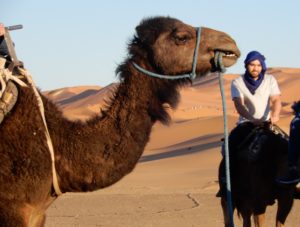 Camel rides in the Sahara, wading in the Mediterranean Sea, a stop at the westernmost point of the entire Euro-Asia land mass. Cathedrals and mosques; great art, history, scenery. The Tomb of Christopher Columbus. Todra Gorge. The Atlas Mountains. Olive trees. Oases. A ferry ride across the Strait of Gibraltar. A day IN Gibraltar, fish and chips and monkeys roaming free. I was delighted to tick off five world capital cities on the trip: Paris, Lisbon, Rabat, Madrid, and Amsterdam. A worthy beginning of my 80th decade.
Camel rides in the Sahara, wading in the Mediterranean Sea, a stop at the westernmost point of the entire Euro-Asia land mass. Cathedrals and mosques; great art, history, scenery. The Tomb of Christopher Columbus. Todra Gorge. The Atlas Mountains. Olive trees. Oases. A ferry ride across the Strait of Gibraltar. A day IN Gibraltar, fish and chips and monkeys roaming free. I was delighted to tick off five world capital cities on the trip: Paris, Lisbon, Rabat, Madrid, and Amsterdam. A worthy beginning of my 80th decade.
I proudly posted this proclamation on my refrigerator door, author is Ethel Peairs Brandon: Will you hear the good news from the horse’s mouth? The first eighty years are the hardest! The second eighty years, so far as my experience goes, are a succession of great parties. Everybody wants to carry your packages and help you up the stairs. If you forget your name or anybody else’s, or forget to fill an appointment, if you promise to be two or three places at the same time or spell words wrong, you need only to explain: You are past eighty.
It’s a great deal better than being sixty-five or seventy….At that time everyone expects you to retire to a little house in a warm climate and become a discontented, fumbling, limping has-been. But if you survive until you’re eighty, everybody is surprised you are still in the land of the living. They are amazed you can walk and astounded that you can be lucid. At seventy, people are mad at you for everything. At eighty, they forgive you for anything. Yes, if you ask me, life begins at eighty!
My 81st birthday this April took a different turn. On March 19 I received the following notice from the Department of State, where I had registered for travel alerts: The Department of State advises U.S. citizens to avoid all international travel due to the global impact of COVID-19. Many countries are experiencing COVID-19 outbreaks and implementing travel restrictions and mandatory quarantines, closing borders, and prohibiting non-citizens from entry with little advance notice. Airlines have cancelled many international flights and several cruise operators have suspended operations or cancelled trips.
 Here in Arkansas, by the end of March directives had closed schools, restricted public gatherings, and shut down most of the things I like to do in Little Rock – such as favorite restaurants, and events and lectures at the Clinton Center. I cooked myself a pan of brownies and celebrated my birthday at home. My azaleas were in full bloom, so that was a beautiful gift from Mother Nature.
Here in Arkansas, by the end of March directives had closed schools, restricted public gatherings, and shut down most of the things I like to do in Little Rock – such as favorite restaurants, and events and lectures at the Clinton Center. I cooked myself a pan of brownies and celebrated my birthday at home. My azaleas were in full bloom, so that was a beautiful gift from Mother Nature.
One of the saddest effects of a quarantined life are the impacts on the elderly, particularly those confined to nursing homes. I have more friends and family than I can count on both hands who are separated from those who love them and are living the last days of their life in isolation.
Yes, it is great to be eighty, as Ethel Brandon proclaimed. But it isn’t great to live in quarantine. Even the very latest directive issued here in Arkansas, as facilities are beginning to open again, states this: Signs must be posted at all entrances advising the public that they may wish to refrain from entering if they are 65 years of age or older. Or if they have underlying health conditions including high blood pressure, chronic lung disease, diabetes, severe obesity, asthma, or weakened immunity.
Us “older folk” lean to humor a lot; it helps alleviate the limitations. Cousin Dwight, the oldest surviving member of my family, is always sending me “old folks jokes” and I received this one in today’s email: To help save the economy, the Government will announce next month that the Immigration Department will start deporting seniors (instead of illegals) in order to lower Social Security and Medicare costs. A major study concluded that older people are easier to catch, offer less resistance, and—most importantly—will not remember how to get back home. Be sure to send this notice to your relatives and friends so they’ll know what happened to you! . . . I started to cry when I thought of you . . . then it dawned on me — I’ll see you on the bus! (author unknown)
It made me laugh, for sure. But seriously speaking – if you know ANYONE who is “home alone” put them on the top of your TO DO list for phone calls, cards, an offer to run errands, a tomato from your garden, anything to let them know they are NOT alone. You can do this if you are eight years old, or eighteen, or, well, even eighty! Maybe, especially if you are eighty, because you are a tried and true survivor.
And THAT is great!
» posted on Saturday, July 2nd, 2022 by Linda Lou Burton
Down to Your Last Nerve
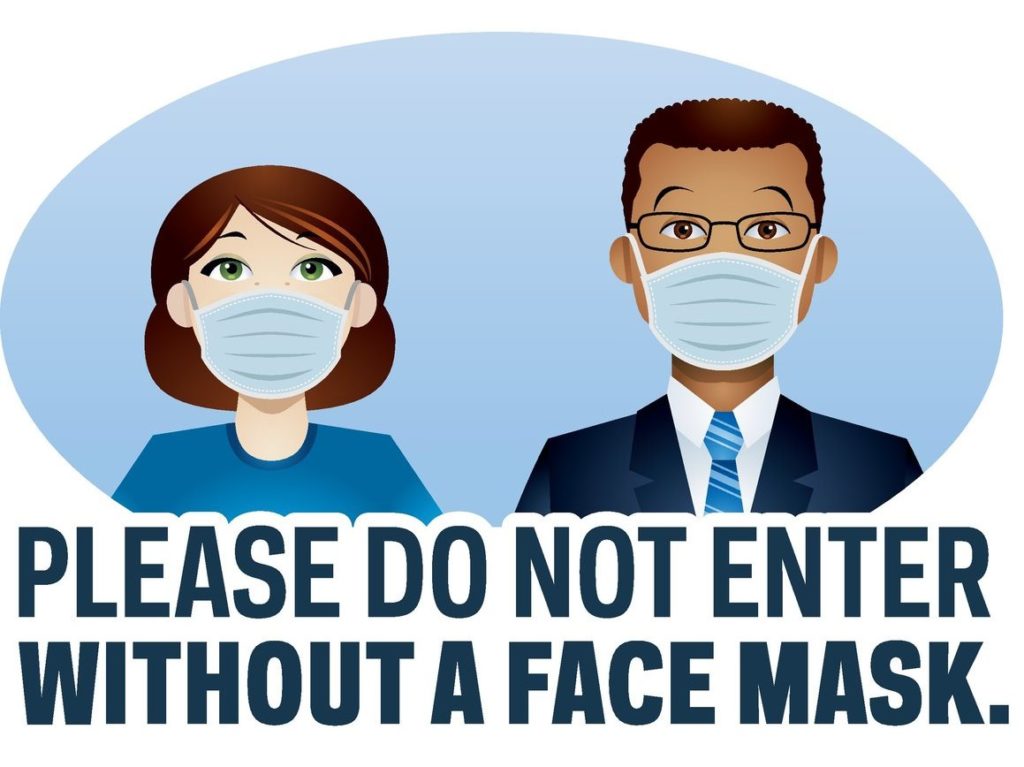 Originally published July 2, 2020 by Linda Lou Burton posting from Little Rock, Arkansas – The weather is hot and the political atmosphere is even hotter as the national holiday celebrating “American Independence” approaches. COVID-19 cases are going UP and not DOWN in many parts of the country, as people clamor for businesses to re-open and defiantly refuse to “mask up” in public places. Jennifer Anniston took to social media yesterday to state: “Just Wear The Damn Mask!”
Originally published July 2, 2020 by Linda Lou Burton posting from Little Rock, Arkansas – The weather is hot and the political atmosphere is even hotter as the national holiday celebrating “American Independence” approaches. COVID-19 cases are going UP and not DOWN in many parts of the country, as people clamor for businesses to re-open and defiantly refuse to “mask up” in public places. Jennifer Anniston took to social media yesterday to state: “Just Wear The Damn Mask!”
Chafing at the Bit describes a lot of feelings after four months of quarantine; a restricted way of life is wearing thin. As my dear friend Betty used to say when she just couldn’t take it anymore: I am down to my last nerve.
 Politics are even hotter than the weather, raw nerves abound. Yesterday in Jackson the Mississippi state flag came down, permanently. A new design has been commissioned, and will be voted on by state residents in November. Mississippi was the last state to have a Confederate emblem on its flag.
Politics are even hotter than the weather, raw nerves abound. Yesterday in Jackson the Mississippi state flag came down, permanently. A new design has been commissioned, and will be voted on by state residents in November. Mississippi was the last state to have a Confederate emblem on its flag. In Richmond, Virginia’s state capital (which was once capital of the Confederacy), a statue of Confederate General Stonewall Jackson came down yesterday as a cheering crowd watched in the rain. In Seattle, CHOP camps (Capitol Hill Organized Protests) were cleared out yesterday after two weeks of standoffs and shootings that were part of the nation’s unrest after the police custody death of George Floyd in Minneapolis.
In Richmond, Virginia’s state capital (which was once capital of the Confederacy), a statue of Confederate General Stonewall Jackson came down yesterday as a cheering crowd watched in the rain. In Seattle, CHOP camps (Capitol Hill Organized Protests) were cleared out yesterday after two weeks of standoffs and shootings that were part of the nation’s unrest after the police custody death of George Floyd in Minneapolis.
Add to that – it’s an election year, and voters are questioning the mental and physical fitness of both our sitting president, and the expected Democratic nominee. Both guys are in their 70s, and both have been criticized for their rambling speeches, and frequent gaffes. “We’re not electing a president this year,” the chatter is, “we’re electing a vice president, that’s who will wind up running the country!”
So dear reader, if you feel that you are “down to your last nerve” about how things are going in 2020 in our “land of the free and home of the brave” let me remind you of something terrible and tumultuous that happened 139 years ago on this date in our nation’s capital.
On July 2, 1881, Charles J Guiteau shot and fatally wounded the newly inaugurated US President James A Garfield in the lobby of the Baltimore & Ohio Railroad Depot in Washington, DC as he yelled, “I am a stalwart and Arthur is now President of the United States!” Guiteau blamed the president for not selecting him for a job at the US Consulate in Paris.
 Mr Garfield’s presidency was cut so short there isn’t enough of a legacy to rank him among the worst and best – he was only in office four months. He was the last president to be born in a log cabin, and grew up poor and fatherless. He was bullied as a child, so took up wrestling. He was our only ambidextrous president, and a great multi-tasker. He was also one of the most well-read of our presidents and his background included being a soldier (he was a major general in the Civil War), a lawyer, a politician, and a math and science expert. Maybe his childhood toughened him up against bullying; as soon as he took office he pioneered the Pendleton Civil Service Reform Act, making it a law that all government jobs be granted on the basis of merit and merit alone.
Mr Garfield’s presidency was cut so short there isn’t enough of a legacy to rank him among the worst and best – he was only in office four months. He was the last president to be born in a log cabin, and grew up poor and fatherless. He was bullied as a child, so took up wrestling. He was our only ambidextrous president, and a great multi-tasker. He was also one of the most well-read of our presidents and his background included being a soldier (he was a major general in the Civil War), a lawyer, a politician, and a math and science expert. Maybe his childhood toughened him up against bullying; as soon as he took office he pioneered the Pendleton Civil Service Reform Act, making it a law that all government jobs be granted on the basis of merit and merit alone.
And then was killed by a man wanting a job. At least, that’s part of the story.
President Garfield did not die immediately, but lingered for eleven weeks, during which time surgeons repeatedly attempted to find the bullet that had lodged in his back. In spite of Joseph Lister’s discoveries regarding the use of antiseptics in surgery, the practice of sterilization had not caught on, and Garfield’s wound was probed by many unwashed fingers. The resulting infection, not the bullet, caused Garfield’s eventual death on September 19, 1881. Vice president Chester A Arthur became president of the United States on September 20.
Garfield’s incapacitation sparked a constitutional crisis, as the Cabinet was divided over whether the vice president should assume the office of the incapacitated president or merely act in his stead. It was not until 1967, with the passage of the Twenty-fifth Amendment to the Constitution, that the question of the succession of power was fully addressed. Today, the vice president assumes the office of president in the event that a sitting president is “unable to discharge the powers and duties of his office.”
In spite of Guiteau’s manifest insanity at his trial, his attorneys were unable to gain an acquittal on that basis—it was, however, one of the first uses of the modern insanity defense in a criminal court. After a six-month trial that sparked great public interest, Guiteau was found guilty and hanged on June 30, 1882.
Note: James Abram Garfield was our 20th president and was 50 years old when assassinated.
Reference: Library of Congress National Archives
Yes, things are definitely nerve-wracking right now. But July 2 was one heck of a bad day for Mr Garfield and Mr Guiteau, if you want to compare. My suggestions for tackling the heat if you have your own lemons to deal with:
- Make yourself a nice tall glass of lemonade.
- Cool down and mask up!
» posted on Friday, July 1st, 2022 by Linda Lou Burton
Deja Re-View
No Mask Needed This Way, July 1, 2020
Originally published July 1, 2020 by Linda Lou Burton posting from Little Rock, Arkansas – I had a friend who had 366 notebooks lining the shelves of his office, labeled with each day of the year, yes, even including Leap. Every day he added a new page in the proper notebook . He could tell you exactly what he was doing, and thinking, and feeling, on any day as far back as twenty years.
On February 29 of this Leap Year, I got news of the first case of the COVID-19 virus in the United States. I was standing in the arena at the fairgrounds here in Little Rock, attending the state Flower & Garden Show with a friend. She was checking her phone for messages, and the news popped up. “Where?” I asked. I’d spent the last month booking reservations for my Round The World trip in July that would take me to the last two continents on my list of seven – Australia and Asia. I had scrupulously avoided China in the plan, due to rumblings of a highly contagious disease and contaminated cruise ships there.
When she told me the case was in Seattle, I was not only startled, but genuinely alarmed, as it was precisely in the area where two of my sons live, with their families. Six grandchildren there! And, Seattle was to be the first stop on the Journey Round The World. My flight was booked for July 7.
“Oh, it will all be done by May,” was the line on everybody’s lips. “Don’t worry.”
I have been tracking the numbers since March 1. As of today 2,624,873 cases have been reported in the United States and its territories by the Centers for Disease Control; with 127,299 deaths from the disease. The only “US soil” that has remained virus-free is American Samoa, which was to be a major stop on my RTW.
There were several kinds of things the RTW would tick off my list of “things to do before I die” (aka Bucket List). I could claim all seven continents as mine; and all five oceans. I would visit the southernmost and northernmost capital cities in the world – Wellington, New Zealand and Reykjavik, Iceland. I would cruise the longest rivers on the continents of Australia and Africa – the Murray and the Nile. I would visit two wonders of the world – Ayers Rock or Uluru, the giant red monolith in the heart of Australia; and the Sphinx and the Pyramids of Giza in Egypt. I would visit three far-flung US National Parks – Haleakala and Hawaii Volcanoes in Hawaii; American Samoa in – well, American Samoa. And best of all, I would add nine world capital cities to my Capital City list! With the added bonus of having my two youngest grandchildren join me in Reykjavik as a “high school graduation gift,” with my RTW ending in Washington, DC with grandkids, in an election year!
This trip would be a crown in my crowns. The grandkids, Kayla and Sam, had been a part of the Journey Across America in 2012; Kayla to Honolulu with me; Sam to Juneau. Now those 4th graders are done with high school! And what a (excuse the language please) SUCKY senior year they were served; schools were closed in March so no senior prom, no bonding with friends, just a Virtual Do and, that’s it. Also, sadly, no trip to Reykjavik, and Washington, DC.
I am now 81 years old, and although the airlines have offered “rebooking” opportunities in years to come, I don’t plan to travel worldwide until the word “pandemic” is erased from our daily conversation and the (currently non-existent) vaccine is keeping everyone, all over the world, SAFE from COVID-19.
So, here’s the deal. I’ll do my traveling VIRTUALLY, and tell you all about it. Plus, I’ll review and update the 51 wonderful capitals I visited on the Journey Across America. I’ve always believed the best thing about travel is the memories; they never RUST or wear out. They nurture you when you are “too old to rock the rocking chair.” (And I am getting close to that.)
On July 1, 2012, I had just returned from Honolulu with Kayla, and was settling in for a two-week stint in Olympia, the capital city of Washington. It was a cool, gray day, as my cats Alex and Jack settled in with me in a peaceful spot.
On July 1, 2013, I was in Des Moines, the capital city of Iowa, where one expected the corn to be “knee high by the 4th of July.” I learned a lot about pigs there too, and genuine Midwestern friendliness.
Today, July 1, 2020, I live in Little Rock, the capital city of Arkansas, with my Katy cat, where Social Distancing is now the required norm, and face masks the recommended attire.
Still in love with capital cities. Still enjoying the world we live in.
Go with me? You won’t even need a face mask!
Knee High By The 4th of July, July 1, 2013
 Linda Burton posting from Des Moines, Iowa – “Oh What A Beautiful Morning!” Remember that Rodgers & Hammerstein tune from Oklahoma? Driving through the Iowa countryside a few days ago, with early summer cornfields rolling across the hills to my right and to my left, I thought of a line from that song “….the corn is as high as an elephants eye….” Then I laughed, because the corn I saw was just beginning to get a grip on growing; it’s pretty darned early in the season here. “That corn is only knee high,” I thought. Later I learned that’s the catch-phrase of corn farmers: “We look for the corn to be knee high by the 4th of July,” I was told. That’s the
Linda Burton posting from Des Moines, Iowa – “Oh What A Beautiful Morning!” Remember that Rodgers & Hammerstein tune from Oklahoma? Driving through the Iowa countryside a few days ago, with early summer cornfields rolling across the hills to my right and to my left, I thought of a line from that song “….the corn is as high as an elephants eye….” Then I laughed, because the corn I saw was just beginning to get a grip on growing; it’s pretty darned early in the season here. “That corn is only knee high,” I thought. Later I learned that’s the catch-phrase of corn farmers: “We look for the corn to be knee high by the 4th of July,” I was told. That’s the  assurance that everything is on track; “elephant’s eye” corn isn’t expected until late September; most harvesting happens in October and sometimes into November. Then there’s a lot of harvesting going on; in 2012 Iowa corn farmers grew almost 1.88 billion bushels of corn, on 13.7 million acres of land; 2013 projections indicate 2.45 billion bushels on 13.97 million acres. Iowa has produced the largest corn crop of any state for more than two decades; in an average year, Iowa produces more corn than most countries! And it’s been the dominant
assurance that everything is on track; “elephant’s eye” corn isn’t expected until late September; most harvesting happens in October and sometimes into November. Then there’s a lot of harvesting going on; in 2012 Iowa corn farmers grew almost 1.88 billion bushels of corn, on 13.7 million acres of land; 2013 projections indicate 2.45 billion bushels on 13.97 million acres. Iowa has produced the largest corn crop of any state for more than two decades; in an average year, Iowa produces more corn than most countries! And it’s been the dominant  crop in Iowa for more than 150 years. The reasons are simple – a growing season that is long enough and warm enough, ample rain, and deep, rich soil. Iowa also produces livestock whose waste includes nutrients that are key to fertilizing the fields for better corn production. According to Iowa Agriculture farm statistics, in 2012 there were 195,000 sheep and lambs on hand, 3.9 million cattle and calves, and 20 million hogs. And, by the way, Iowa is the number one pork producing state in the country too.
crop in Iowa for more than 150 years. The reasons are simple – a growing season that is long enough and warm enough, ample rain, and deep, rich soil. Iowa also produces livestock whose waste includes nutrients that are key to fertilizing the fields for better corn production. According to Iowa Agriculture farm statistics, in 2012 there were 195,000 sheep and lambs on hand, 3.9 million cattle and calves, and 20 million hogs. And, by the way, Iowa is the number one pork producing state in the country too.
I went to the Iowa Agriculture website for some basic farm facts; I wanted to know how many farms there are in Iowa, overall. The answer (as of 2011) is 92,300 farms, covering 30.7  million acres of the state. The size of an average farm is 333 acres, valued at about $6,708 per acre. That long growing season I mentioned has temperatures ranging from an average of 13.2F in January to 75.3F in July, with an average annual rainfall of 45.10 inches. Soybeans, milk, and eggs are other biggies in the state; 466 million bushels of soybeans grown on 9.23 million acres in 2011; 4.33 billion pounds of milk produced; 14.5 billion eggs. Equate that to how many glasses of milk you drink in a week, or how many sunny-side-up breakfasts you enjoy. As to the bacon that accompanies those breakfast eggs – I pulled some numbers from the National Pork Board and the US Census of Agriculture. Iowa has about 8,300 hog operations; more than 39,000 jobs are directly related to raising and caring for hogs in Iowa; the industry generates nearly $950 million in household income for pork producers.
million acres of the state. The size of an average farm is 333 acres, valued at about $6,708 per acre. That long growing season I mentioned has temperatures ranging from an average of 13.2F in January to 75.3F in July, with an average annual rainfall of 45.10 inches. Soybeans, milk, and eggs are other biggies in the state; 466 million bushels of soybeans grown on 9.23 million acres in 2011; 4.33 billion pounds of milk produced; 14.5 billion eggs. Equate that to how many glasses of milk you drink in a week, or how many sunny-side-up breakfasts you enjoy. As to the bacon that accompanies those breakfast eggs – I pulled some numbers from the National Pork Board and the US Census of Agriculture. Iowa has about 8,300 hog operations; more than 39,000 jobs are directly related to raising and caring for hogs in Iowa; the industry generates nearly $950 million in household income for pork producers.
Enough with the numbers; I wanted to know what kind of hogs are raised, and what is different about each breed. But first a little Pig Latin Lesson: “boars” are males of breeding  age; “sows” are breeding females; and “piglets” need no explanation; they are the unweaned little ones.
age; “sows” are breeding females; and “piglets” need no explanation; they are the unweaned little ones.
From the Des Moines National Pork Board website, which also has delicious recipes for the use of pork, I learned that most hogs bred for consumption are the offspring of a combination of breeds – usually dark-breed boars bred to white-breed sows. Dark breed boars enhance meat quality; white-breed sows produce many piglets, plus their maternal instincts allow more piglets to survive. A producer will choose a particular breed, or combination of genetic lines, based on what they are looking for with regard to meat quality, farming method, and the hog market. Here are eight of the most widely popular.
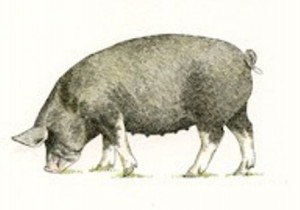 Berkshire. A black pig that originated in Britain in the mid-1500s, prized for juiciness, flavor, and tenderness, yielding a pink-hued, heavily marbled meat suitable for long cooking times.
Berkshire. A black pig that originated in Britain in the mid-1500s, prized for juiciness, flavor, and tenderness, yielding a pink-hued, heavily marbled meat suitable for long cooking times. Chester White. Used in commercial crossbreeding; originated in Pennsylvania in the early 1800s when white pigs common to the northeast US were bred with a white boar imported from Bedfordshire, England.
Chester White. Used in commercial crossbreeding; originated in Pennsylvania in the early 1800s when white pigs common to the northeast US were bred with a white boar imported from Bedfordshire, England. Duroc. Known for quick growth; red or black coloring; the second most recorded breed in the US; a main sire choice of American farmers. Sweet meat, amazing shoulders and spareribs.
Duroc. Known for quick growth; red or black coloring; the second most recorded breed in the US; a main sire choice of American farmers. Sweet meat, amazing shoulders and spareribs.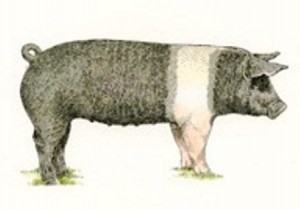 Hampshire. Fourth most recorded breed in America and oldest American breed in existence; stock imported from Wessex, England in 1832. Black with a white belt across the shoulders, a lean-meat breed.
Hampshire. Fourth most recorded breed in America and oldest American breed in existence; stock imported from Wessex, England in 1832. Black with a white belt across the shoulders, a lean-meat breed. Landrace. Fifth most recorded breed in the US; known for large litters of piglets. A white pig, descended from the Danish Landrace; produces a large and flavorful ham and loin.
Landrace. Fifth most recorded breed in the US; known for large litters of piglets. A white pig, descended from the Danish Landrace; produces a large and flavorful ham and loin.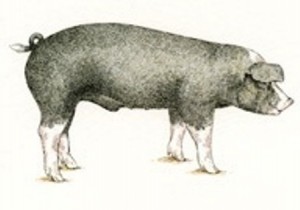 Poland China. Black with white face and feet, derives from many breeds, including the Berkshire and the Hampshire. Known for large size; one of the most common breeds in the US.
Poland China. Black with white face and feet, derives from many breeds, including the Berkshire and the Hampshire. Known for large size; one of the most common breeds in the US. Spotted Pig. Black and white spots, no red or brown; popular in the US because of high meat quality and ability to gain weight quickly.
Spotted Pig. Black and white spots, no red or brown; popular in the US because of high meat quality and ability to gain weight quickly. Yorkshire. #1 recorded breed in the US; white, very durable and muscular, high proportion of lean meat. Developed in the county of York, England, and brought to the US around 1830.
Yorkshire. #1 recorded breed in the US; white, very durable and muscular, high proportion of lean meat. Developed in the county of York, England, and brought to the US around 1830.
Now that you’re up on pigs, let’s get back to corn. Because, you see, most Iowa corn goes into animal feed. One bushel of corn converts to about 13 pounds of retail pork. Iowa’s corn is  also processed into starches, oil, sweeteners, and ethanol. Most of the corn you see growing in fields across Iowa is field corn, not the sweet corn-on-the-cob you think about for summer cookouts, dripping with butter. The sweet corn that is grown in Iowa is usually sold at farmers’ markets and roadside stands, not shipped out of state, so if you live in Arizona or Vermont, you’ll likely never see Iowa corn in your supermarket. But it will be in products you use – the Corn Refiners Association has conducted surveys tallying all supermarket products that contain corn ingredients and come up with the staggering number of at least 4,000. Read your labels! Corn is nearly everywhere – even used in paper products.
also processed into starches, oil, sweeteners, and ethanol. Most of the corn you see growing in fields across Iowa is field corn, not the sweet corn-on-the-cob you think about for summer cookouts, dripping with butter. The sweet corn that is grown in Iowa is usually sold at farmers’ markets and roadside stands, not shipped out of state, so if you live in Arizona or Vermont, you’ll likely never see Iowa corn in your supermarket. But it will be in products you use – the Corn Refiners Association has conducted surveys tallying all supermarket products that contain corn ingredients and come up with the staggering number of at least 4,000. Read your labels! Corn is nearly everywhere – even used in paper products.
And corn grows nearly everywhere; you’ll find it on every continent except Antarctica. It is descended from a plant called teosinte, which still grows in Mexico; the first corn plants seem to have appeared in Mexico. Millenniums of breeding, first by Native Americans, then by  early pilgrims and modern scientists, have resulted in larger, fuller ears, and made corn one of the world’s three leading grain crops (rice and wheat are the others). Much of Iowa’s field corn is bred to develop just one large ear rather than several incomplete ears; the number of kernels per ear vary from 500 to 1,200, but a typical ear has about 800 kernels. A bushel of shelled corn (after husks and cobs are removed) weighs about 56 pounds and last year Iowa corn growers harvested an average of 172 bushels per acre of land (the national average was 147). To further visualize, an acre is about the size of a standard football field.
early pilgrims and modern scientists, have resulted in larger, fuller ears, and made corn one of the world’s three leading grain crops (rice and wheat are the others). Much of Iowa’s field corn is bred to develop just one large ear rather than several incomplete ears; the number of kernels per ear vary from 500 to 1,200, but a typical ear has about 800 kernels. A bushel of shelled corn (after husks and cobs are removed) weighs about 56 pounds and last year Iowa corn growers harvested an average of 172 bushels per acre of land (the national average was 147). To further visualize, an acre is about the size of a standard football field.
 About those husks and cobs – when corn is harvested the combine strips the husks off each ear and removes the kernels; the kernels are stored in a holding tank until they can be unloaded into a truck. But the husks and cobs are spread back into the field as the combine moves along; it’s just like mulch in your home garden. Good soil fertility is there for the next crop; corn plants that will grow up to 12 feet tall, just about as high, I’m thinking, as an elephant’s eye.
About those husks and cobs – when corn is harvested the combine strips the husks off each ear and removes the kernels; the kernels are stored in a holding tank until they can be unloaded into a truck. But the husks and cobs are spread back into the field as the combine moves along; it’s just like mulch in your home garden. Good soil fertility is there for the next crop; corn plants that will grow up to 12 feet tall, just about as high, I’m thinking, as an elephant’s eye.
Sunday Morning Coming Down, July 1, 2012
 Linda Burton posting from Olympia, Washington – The joke is “summer doesn’t arrive in the Pacific Northwest until after the 4th of July” but it’s no joke. In 1987 I dried out in front of a blazing fire after giving up on the soggy Seattle fireworks display and coming home sopping wet and shivering. It looks as though this year will follow that pattern; it was raining when I woke up; a Sunday morning gray. A cat snuggled tight against either side of me; I guess I’m forgiven for taking off for Hawaii and leaving them behind. I opened up the Fancy Feast and then slept two hours more. Under the blanket and the pile of cats it was cozy and warm, but checkout time loomed close; time to load the car, drive to Olympia, unload everything, settle in for the next two-week stint. I was misty-soaked and feeling blue in all the gray, my body temp still set on Hawaiian warm. Just drive, I told myself.
Linda Burton posting from Olympia, Washington – The joke is “summer doesn’t arrive in the Pacific Northwest until after the 4th of July” but it’s no joke. In 1987 I dried out in front of a blazing fire after giving up on the soggy Seattle fireworks display and coming home sopping wet and shivering. It looks as though this year will follow that pattern; it was raining when I woke up; a Sunday morning gray. A cat snuggled tight against either side of me; I guess I’m forgiven for taking off for Hawaii and leaving them behind. I opened up the Fancy Feast and then slept two hours more. Under the blanket and the pile of cats it was cozy and warm, but checkout time loomed close; time to load the car, drive to Olympia, unload everything, settle in for the next two-week stint. I was misty-soaked and feeling blue in all the gray, my body temp still set on Hawaiian warm. Just drive, I told myself.
It’s a mess, I-5 I mean; and the speed limit is 60 all the way; what’s that about? The Girl Scout motto learned so many years ago forgot, I put no water for the kitties in the back; didn’t fill the litter box; it was a short drive to Olympia.  And so you see, I was not prepared for the rooms reserved weeks ago to be refused to me. A chain I often used, this one did not accept cats; my “Pet Friendly” filter somehow slipped. (Big expose some day, about the inconsistencies of chains, and the unkindnesses to pets!) They refused me gently though, and called to find a room for me. A downtown highrise, not my favorite choice, but decision-making time was running short (no water, and no litter box).
And so you see, I was not prepared for the rooms reserved weeks ago to be refused to me. A chain I often used, this one did not accept cats; my “Pet Friendly” filter somehow slipped. (Big expose some day, about the inconsistencies of chains, and the unkindnesses to pets!) They refused me gently though, and called to find a room for me. A downtown highrise, not my favorite choice, but decision-making time was running short (no water, and no litter box).
My reaction was muted by the gray; okay, I’ll take the room. It wasn’t ready yet, please sort it out, I begged. Housekeeper beeped another floor, got somebody on it, quick. “Start your unload,” she soothed, “and bring those kitties in.” She described her long-haired cat, her love of 15 years, “I want to meet your Jack,” she smiled, “and Alex too.” I warmed from blue to pink. Four loads with the rattley cart; four floors on the elevator; and then, we’re home and all is well. Let’s watch the evening news, and catch up with the rest of the world.
 It’s pleasant here. No doubt that things would turn out fine; I’ve got the Bubble over me. Dig through the suitcase for warmer clothes, zip the black sweater clear up to my neck, pull on some socks. It was 109 in Nashville today, the Brian Williams Sunday-substitute is telling on the news, and power’s out all in the stormy east. But I am safe, here at the end of Puget Sound, looking forward to the peace, and quiet, and gentle soothing gray; an easy place to be.
It’s pleasant here. No doubt that things would turn out fine; I’ve got the Bubble over me. Dig through the suitcase for warmer clothes, zip the black sweater clear up to my neck, pull on some socks. It was 109 in Nashville today, the Brian Williams Sunday-substitute is telling on the news, and power’s out all in the stormy east. But I am safe, here at the end of Puget Sound, looking forward to the peace, and quiet, and gentle soothing gray; an easy place to be.
» posted on Saturday, September 19th, 2020 by Linda Lou Burton
A Talking-To
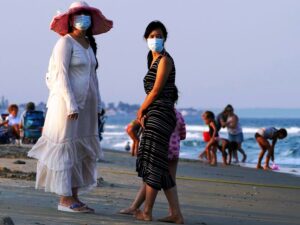 Linda Lou Burton posting from Little Rock, Arkansas – Summer is nearing an end, and I’m wagging my finger to get your attention this Saturday evening about COVID19 in the United States and the World. The virus hasn’t disappeared yet, and sadly, the United States continues to be coping poorly. The World Health Organization reports 30,369,778 cases tallied up around the globe as of September 19. The Centers for Disease Control reports 6,706,374 cases in the United States as of September 19. Do the math: 22% of the COVID19 cases in the world are in the United States. And remember, the United States accounts for only 4% of the world’s population.
Linda Lou Burton posting from Little Rock, Arkansas – Summer is nearing an end, and I’m wagging my finger to get your attention this Saturday evening about COVID19 in the United States and the World. The virus hasn’t disappeared yet, and sadly, the United States continues to be coping poorly. The World Health Organization reports 30,369,778 cases tallied up around the globe as of September 19. The Centers for Disease Control reports 6,706,374 cases in the United States as of September 19. Do the math: 22% of the COVID19 cases in the world are in the United States. And remember, the United States accounts for only 4% of the world’s population.
I REPEAT:
- WORLD COVID19 cases: 30,369,778
- UNITED STATES COVID19 cases: 6,706,374
- UNITED STATES: 22% of World COVID19 cases
- UNITED STATES: 4% of World population
As to DEATHS from COVID19, the World Health Organization reports 948,795 deaths worldwide due to COVID19 as of September 19. The Centers for Disease Control reports 198,099 deaths in the United States due to COVID19 as of September 19.
My stepmother was one of those statistics. She was buried September 13 in Jasper, Alabama (Alabama now the fifth deadliest state to live in). Her name was Opal Burton and she lived for 97 years, until she contracted the virus while quarantined in a nursing home. Not the way anyone should spend their last days on earth; she was in a place that should have been able to keep her safe. It makes me sad, and it makes me angry that we have let this virus dig into our lives the way it has. God bless you Opal, and forgive the laxity that allowed things to get so far beyond control. Your life was much too valuable to be lost in such a way.
DEATHS:
- WORLD COVID19 deaths: 948,795
- UNITED STATES COVID19 deaths: 198,099
- UNITED STATES: 21% of World COVID19 deaths
- UNITED STATES: 4% of World Population
Within the United States, which states have the WORST RECORD?
The FIVE STATES with the HIGHEST percentage of their population DIAGNOSED with COVID19:
- Louisiana: 3.47%. Governor John Bell Edwards, Democrat
- Mississippi: 3.13%. Governor Tate Reeves, Republican
- Florida: 3.12%. Governor Ron DeSantis, Republican
- Arizona: 2.93%. Governor Doug Ducey, Republican
- Alabama: 2.91%. Governor Kay Ivey, Republican
Of those who contracted COVID19, the FIVE STATES with the HIGHEST percentage of those DYING from the virus:
- Connecticut: 8.09%. Governor Ned Lamont, Democrat
- New Jersey: 8.08%. Governor Phil Murphy, Democrat
- New York: 7.29%. Governor Andrew Cuomo, Democrat
- Massachusetts: 6.89%. Governor Charles Baker, Republican
- New Hampshire: 5.57%. Governor Chris Sununu, Republican
 We’ve got to do better people. What are YOU doing personally to make sure the virus doesn’t grab onto your beautiful body? And if it unfortunately HAS DONE THAT, and you are feverish and coughing and feel totally pukey BAD, what are you doing to make sure you don’t spread it around? Our powers in office can make good or bad decisions about issuing mandates and opening or closing facilities. But it is up to YOU to practice good common sense. You’ve heard enough details about COVID19 symptoms, and dangers. You know the drill. In all the political froo-froo and blame-game playacting, it’s still WE THE PEOPLE who can slow the virus down by sensible behavior and good judgment. Don’t be a ding-dong!
We’ve got to do better people. What are YOU doing personally to make sure the virus doesn’t grab onto your beautiful body? And if it unfortunately HAS DONE THAT, and you are feverish and coughing and feel totally pukey BAD, what are you doing to make sure you don’t spread it around? Our powers in office can make good or bad decisions about issuing mandates and opening or closing facilities. But it is up to YOU to practice good common sense. You’ve heard enough details about COVID19 symptoms, and dangers. You know the drill. In all the political froo-froo and blame-game playacting, it’s still WE THE PEOPLE who can slow the virus down by sensible behavior and good judgment. Don’t be a ding-dong!
In 45 days, it’s time to VOTE. Stay tuned for a daily post about each of the 45 presidents who have already served, from GEORGE to DONALD. You DO NOT want to miss that. If you think things are crazy NOW, well, they are, but there has been mucho craziness in the past too.
Don’t despair. You know what to do on November 3.
» posted on Monday, September 7th, 2020 by Linda Lou Burton
Know Your Neighbors 2 – South America
September 7, 2020, Linda Lou Burton posting from Little Rock, Arkansas – A little more  detail on the twelve countries of South America. Which country has the largest military budget? Which country has the lowest per capita GDP? Which countries have emeralds and diamonds? Which country has Dutch as their official language? In which country is life expectancy for females the highest? In which country is life expectancy for males the lowest? In which country do the most people claim to be Catholic? How well do you know your neighbors?
detail on the twelve countries of South America. Which country has the largest military budget? Which country has the lowest per capita GDP? Which countries have emeralds and diamonds? Which country has Dutch as their official language? In which country is life expectancy for females the highest? In which country is life expectancy for males the lowest? In which country do the most people claim to be Catholic? How well do you know your neighbors?
Countries in South America
- Argentina
- Bolivia
- Brazil
- Chile
- Colombia
- Ecuador
- Guyana
- Paraguay
- Peru
- Suriname
- Uruguay
- Venezuela
Argentina, Capital City Buenos Aires
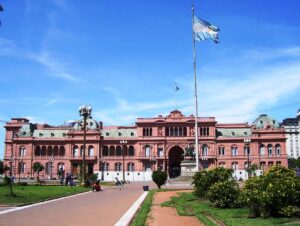 Argentina, the third largest South American country by population (45,089,492), is a presidential republic with a president as head of state and head of government. The official language is Spanish and the country is 77% Catholic and 11% Protestant and 7% Agnostic. The defense budget is $4.2 billion and there are 74,200 active troops. Natural resources are lead, copper, iron ore, petroleum. The Per Capita GDP is $20,567. Compulsory education ages 4-17. Life expectancy female 81.0; male 74.5.
Argentina, the third largest South American country by population (45,089,492), is a presidential republic with a president as head of state and head of government. The official language is Spanish and the country is 77% Catholic and 11% Protestant and 7% Agnostic. The defense budget is $4.2 billion and there are 74,200 active troops. Natural resources are lead, copper, iron ore, petroleum. The Per Capita GDP is $20,567. Compulsory education ages 4-17. Life expectancy female 81.0; male 74.5.
Bolivia, Capital City La Paz
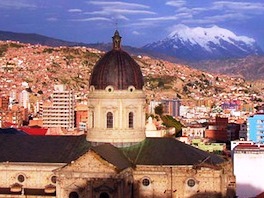 Bolivia, the eighth largest South American country by population (11,473,676), is a presidential republic with a president as head of state and head of government. The primary language is Spanish and the country is 79% Catholic and 9% Protestant. The defense budget is $533 million and there are 34,100 active troops. Natural resources are natural gas, iron ore, petroleum, timber. The Per Capita GDP is $7,859. Compulsory education ages 4-17. Life expectancy female 73.1; male 67.3.
Bolivia, the eighth largest South American country by population (11,473,676), is a presidential republic with a president as head of state and head of government. The primary language is Spanish and the country is 79% Catholic and 9% Protestant. The defense budget is $533 million and there are 34,100 active troops. Natural resources are natural gas, iron ore, petroleum, timber. The Per Capita GDP is $7,859. Compulsory education ages 4-17. Life expectancy female 73.1; male 67.3.
Brazil, Capital City Brasilia
 Brazil, the largest South American country by population (210,301,591), is a federal presidential republic with a president as head of state and head of government. The official language is Portuguese and the country is 65% Catholic, 14% Protestant, and 11% Independent. The defense budget is $28 billion and there are 334,500 active troops. Natural resources are gold, iron ore, petroleum, timber. The Per Capita GDP is $16,068. Compulsory education ages 4-17. Life expectancy female 78.2; male 71.0.
Brazil, the largest South American country by population (210,301,591), is a federal presidential republic with a president as head of state and head of government. The official language is Portuguese and the country is 65% Catholic, 14% Protestant, and 11% Independent. The defense budget is $28 billion and there are 334,500 active troops. Natural resources are gold, iron ore, petroleum, timber. The Per Capita GDP is $16,068. Compulsory education ages 4-17. Life expectancy female 78.2; male 71.0.
Chile, Capital City Santiago
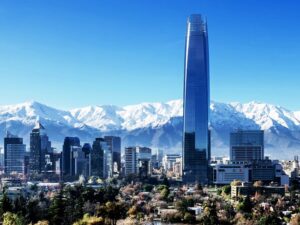 Chile, the sixth largest South American country by population (18,057,855), is a presidential republic with a president as head of state and head of government. The official language is Spanish and the country is 61% Catholic, 22% Independent, and 9% Agnostic. The defense budget is $4.2 billion and there are 77,200 active troops. Natural resources are copper, timber, nitrates, hydropower. The Per Capita GDP is $25,284. Compulsory education ages 5-17. Life expectancy female 82.4; male 76.2.
Chile, the sixth largest South American country by population (18,057,855), is a presidential republic with a president as head of state and head of government. The official language is Spanish and the country is 61% Catholic, 22% Independent, and 9% Agnostic. The defense budget is $4.2 billion and there are 77,200 active troops. Natural resources are copper, timber, nitrates, hydropower. The Per Capita GDP is $25,284. Compulsory education ages 5-17. Life expectancy female 82.4; male 76.2.
Colombia, Capital City Bogota
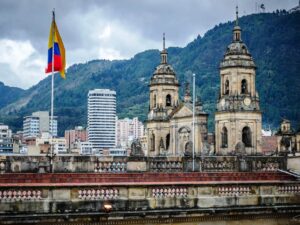 Colombia, the second largest South American country by population (48,631,464), is a presidential republic with a president as head of state and head of government. The official language is Spanish and the country is 86% Catholic, 9% Protestant, and 3% Agnostic. The defense budget is $10.6 billion and there are 292,200 active troops. Natural resources are copper, emeralds, hydropower. The Per Capita GDP is $14,999. Compulsory education ages 5-14. Life expectancy female 79.7; male 73.3.
Colombia, the second largest South American country by population (48,631,464), is a presidential republic with a president as head of state and head of government. The official language is Spanish and the country is 86% Catholic, 9% Protestant, and 3% Agnostic. The defense budget is $10.6 billion and there are 292,200 active troops. Natural resources are copper, emeralds, hydropower. The Per Capita GDP is $14,999. Compulsory education ages 5-14. Life expectancy female 79.7; male 73.3.
Ecuador, Capital City Quito
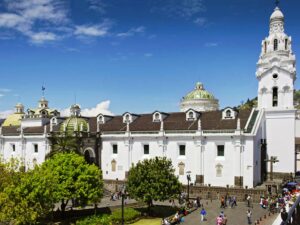 Ecuador, the seventh largest South American country by population (16,703,254), is a presidential republic with a president as head of state and head of government. The official language is Spanish and the country is 84% Catholic, 11% Protestant, and 4% Agnostic. The defense budget is $1.7 billion and there are 40,250 active troops. Natural resources are petroleum, fish, timber, hydropower. The Per Capita GDP is $11,714. Compulsory education ages 3-17. Life expectancy female 80.5; male 74.4.
Ecuador, the seventh largest South American country by population (16,703,254), is a presidential republic with a president as head of state and head of government. The official language is Spanish and the country is 84% Catholic, 11% Protestant, and 4% Agnostic. The defense budget is $1.7 billion and there are 40,250 active troops. Natural resources are petroleum, fish, timber, hydropower. The Per Capita GDP is $11,714. Compulsory education ages 3-17. Life expectancy female 80.5; male 74.4.
Guyana, Capital City Georgetown
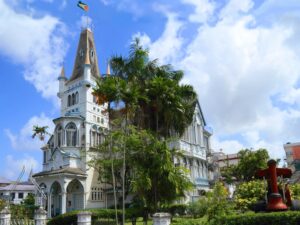 Guyana, the eleventh largest South American country by population (744,845), is a parliamentary republic with a president as head of state and head of government. The official language is English and the country is 34% Protestant, 30% Hindu, 11% Independent, and 8% Muslim. The defense budget is $56 million and there are 3,400 active troops. Natural resources are bauxite, diamonds, timber, shrimp. The Per Capita GDP is $8,569. Compulsory education ages 6-11. Life expectancy female 72.4; male 66.2.
Guyana, the eleventh largest South American country by population (744,845), is a parliamentary republic with a president as head of state and head of government. The official language is English and the country is 34% Protestant, 30% Hindu, 11% Independent, and 8% Muslim. The defense budget is $56 million and there are 3,400 active troops. Natural resources are bauxite, diamonds, timber, shrimp. The Per Capita GDP is $8,569. Compulsory education ages 6-11. Life expectancy female 72.4; male 66.2.
Paraguay, Capital City Asuncion
 Paraguay, the ninth largest South American country by population (7,108,524), is a presidential republic with a president as head of state and head of government. The official languages are Spanish and Guarani and the country is 85% Catholic, 11% Protestant. The defense budget is $313 million and there are 11,500 active troops. Natural resources are hydropower, timber, limestone. The Per Capita GDP is $13,571. Compulsory education ages 5-17. Life expectancy female 80.5; male 75.0.
Paraguay, the ninth largest South American country by population (7,108,524), is a presidential republic with a president as head of state and head of government. The official languages are Spanish and Guarani and the country is 85% Catholic, 11% Protestant. The defense budget is $313 million and there are 11,500 active troops. Natural resources are hydropower, timber, limestone. The Per Capita GDP is $13,571. Compulsory education ages 5-17. Life expectancy female 80.5; male 75.0.
Peru, Capital City Lima
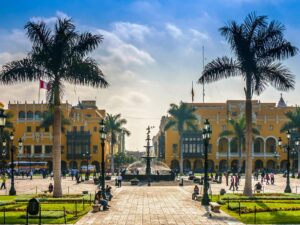 Peru, the fifth largest South American country by population (31,624,207), is a presidential republic with a president as head of state and head of government. The official languages are Spanish, Quechua and Aymara and the country is 84% Catholic, 12% Protestant. The defense budget is $2.3 billion and there are 81,000 active troops. Natural resources are copper, petroleum, fish, coal. The Per Capita GDP is $14,393. Compulsory education ages 3-16. Life expectancy female 76.7; male 72.3.
Peru, the fifth largest South American country by population (31,624,207), is a presidential republic with a president as head of state and head of government. The official languages are Spanish, Quechua and Aymara and the country is 84% Catholic, 12% Protestant. The defense budget is $2.3 billion and there are 81,000 active troops. Natural resources are copper, petroleum, fish, coal. The Per Capita GDP is $14,393. Compulsory education ages 3-16. Life expectancy female 76.7; male 72.3.
Suriname, Capital City Paramaribo
 Suriname, the smallest South American country by population (603,823), is a presidential republic with a president as head of state and head of government. The official language is Dutch though English is widely spoken, and the country is 30% Catholic, 20% Hindu, 16% Muslim, 15% Protestant, 5% Agnostic . The defense budget is NA and there are 1,840 active troops. Natural resources are timber, hydropower, fish, gold. The Per Capita GDP is $15,498. Compulsory education ages 7-12. Life expectancy female 75.6; male 70.6.
Suriname, the smallest South American country by population (603,823), is a presidential republic with a president as head of state and head of government. The official language is Dutch though English is widely spoken, and the country is 30% Catholic, 20% Hindu, 16% Muslim, 15% Protestant, 5% Agnostic . The defense budget is NA and there are 1,840 active troops. Natural resources are timber, hydropower, fish, gold. The Per Capita GDP is $15,498. Compulsory education ages 7-12. Life expectancy female 75.6; male 70.6.
Uruguay, Capital City Montevideo
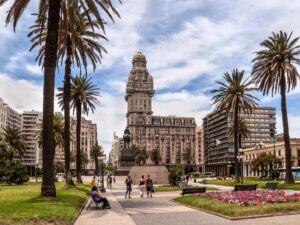 Uruguay, the tenth largest South American country by population (3,378,471), is a presidential republic with a president as head of state and head of government. The official language is Spanish and the country is 52% Catholic, 30% Agnostic, 9% Protestant, 7% Atheist. The defense budget is $486 million and there are 21,000 active troops. Natural resources are hydropower, fish, minor minerals. The Per Capita GDP is $23,531. Compulsory education ages 4-17. Life expectancy female 81.0; male 74.6.
Uruguay, the tenth largest South American country by population (3,378,471), is a presidential republic with a president as head of state and head of government. The official language is Spanish and the country is 52% Catholic, 30% Agnostic, 9% Protestant, 7% Atheist. The defense budget is $486 million and there are 21,000 active troops. Natural resources are hydropower, fish, minor minerals. The Per Capita GDP is $23,531. Compulsory education ages 4-17. Life expectancy female 81.0; male 74.6.
Venezuela, Capital City Caracas
 Venezuela, the fourth largest South American country by population (32,068,672), is a federal presidential republic with a president as head of state and head of government. The official language is Spanish and the country is 81% Catholic, 11% Protestant, 5% Agnostic. The defense budget is $741 million and there are 123,000 active troops. Natural resources are petroleum, gold, hydropower, diamonds. The Per Capita GDP is $18,102. Compulsory education ages 3-18. Life expectancy female 79.5; male 73.4.
Venezuela, the fourth largest South American country by population (32,068,672), is a federal presidential republic with a president as head of state and head of government. The official language is Spanish and the country is 81% Catholic, 11% Protestant, 5% Agnostic. The defense budget is $741 million and there are 123,000 active troops. Natural resources are petroleum, gold, hydropower, diamonds. The Per Capita GDP is $18,102. Compulsory education ages 3-18. Life expectancy female 79.5; male 73.4.
Resource: The World Almanac and Book of Facts 2020
» posted on Sunday, September 6th, 2020 by Linda Lou Burton
Know Your Neighbors – South America
September 6, 2020, Linda Lou Burton posting from Little Rock, Arkansas – Do you know your geography? There are twelve countries in South America – I keep up with them by memorizing them alphabetically.
- Argentina
- Bolivia
- Brazil
- Chile
- Colombia
- Ecuador
- Guyana
- Paraguay
- Peru
- Suriname
- Uruguay
- Venezuela
Where do the most people live?
- Brazil – 210,301,591
- Colombia – 48,631,464
- Argentina – 45,089,492
- Venezuela – 32,068,672
- Peru – 31,624,207
- Chile – 18,057,855
- Ecuador – 16,703,254
- Bolivia – 11,473,676
- Paraguay – 7,108,524
- Uruguay – 3,378,471
- Guyana – 744,845
- Suriname – 603,823
If you had to walk across it, which county would take the longest? Which is largest in square miles?
- Brazil – 3,287,957
- Argentina – 1,073,518
- Peru – 496,225
- Colombia – 439,736
- Bolivia – 424,164
- Venezuela – 352,144
- Chile – 291,933
- Paraguay – 153,399
- Ecuador – 109,484
- Guyana – 83,000
- Uruguay – 68,037
- Suriname – 63,251
Which country has the highest percentage of internet users? Most technologically inclined?
- Chile – 82.3%
- Argentina – 74.3%
- Venezuela – 72.0%
- Uruguay – 68.3%
- Brazil – 67.5
- Paraguay – 65.0%
- Colombia – 62.3%
- Ecuador – 57.3%
- Peru – 52.5%
- Suriname – 48.9%
- Bolivia – 43.8%
- Guyana – 37.3%
Which country has the highest literacy rate? Percent of population able to read and write?
- Argentina – 99.1%
- Uruguay – 98.6%
- Venezuela – 97.1%
- Chile – 96.9%
- Suriname – 95.6%
- Colombia – 94.7%
- Paraguay – 94.7%
- Ecuador – 94.4%
- Peru – 94.1%
- Brazil – 92.6%
- Bolivia – 92.5%
- Guyana – 88.5%
Which country has the highest population density? How many people are there per square mile? Close to each other or lots of breathing space?
- Ecuador – 156
- Colombia – 121
- Venezuela – 94
- Brazil – 65
- Peru – 64
- Chile – 63
- Uruguay – 50
- Paraguay – 46
- Argentina – 43
- Bolivia- 27
- Guyana – 10
- Suriname – 10
Which country has had the most confirmed DEATHS from COVID19 in 2020 to date?
- Brazil – 126,960
- Peru – 29,976
- Colombia – 21,615
- Chile – 11,682
- Argentina – 10,179
- Bolivia – NA
- Ecuador – NA
- Guyana – NA
- Paraguay – NA
- Suriname – NA
- Uruguay – NA
- Venezuela – NA
Which country has had the most confirmed CASES of COVID19 reported in 2020 to date?
- Brazil – 4,147,794
- Peru – 691,575
- Colombia – 671,848
- Argentina – 488,007
- Chile – 425,541
- Bolivia – NA
- Ecuador – NA
- Guyana – NA
- Paraguay – NA
- Suriname – NA
- Uruguay – NA
- Venezuela – NA
Resources: World Almanac and Book of Facts 2020 and World Health Organization
» posted on Saturday, September 5th, 2020 by Linda Lou Burton
Know Your Neighbors 2 – North America
 Linda Lou Burton posting from Little Rock, Arkansas – A little more detail on the ten countries of North America. Which country has the largest military budget? Which country has the lowest per capita GDP? Which country has mahogany forests? Which countries do not have an official language? In which country is life expectancy for females the highest? In which country is life expectancy for males the lowest? In which country do the most people claim to be Catholic? In how many countries is Queen Elizabeth II Head of State? How well do you know your neighbors?
Linda Lou Burton posting from Little Rock, Arkansas – A little more detail on the ten countries of North America. Which country has the largest military budget? Which country has the lowest per capita GDP? Which country has mahogany forests? Which countries do not have an official language? In which country is life expectancy for females the highest? In which country is life expectancy for males the lowest? In which country do the most people claim to be Catholic? In how many countries is Queen Elizabeth II Head of State? How well do you know your neighbors?
Alphabetical List of Countries in North America
- Belize
- Canada
- Costa Rica
- El Salvador
- Guatemala
- Honduras
- Mexico
- Nicaragua
- Panama
- United States
Belize, Capital City Belmopan
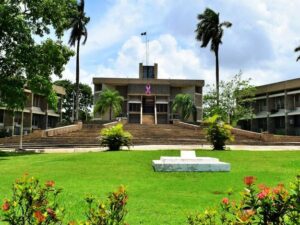 Belize, the smallest North American country by population (392,771), is a parliamentary democracy under a constitutional monarchy with Queen Elizabeth II as Head of State. There is a Governor-General representing the Queen, and Prime Minister as Head of Government. The official language is English and the country is 61% Catholic and 27% Protestant. The defense budget is $23 million and there are 1,500 active troops. Natural resources are timber, fish, and hydropower. The Per Capita GPD is $8,786. Compulsory education ages 5-12. Life expectancy female 76.7; male 73.4.
Belize, the smallest North American country by population (392,771), is a parliamentary democracy under a constitutional monarchy with Queen Elizabeth II as Head of State. There is a Governor-General representing the Queen, and Prime Minister as Head of Government. The official language is English and the country is 61% Catholic and 27% Protestant. The defense budget is $23 million and there are 1,500 active troops. Natural resources are timber, fish, and hydropower. The Per Capita GPD is $8,786. Compulsory education ages 5-12. Life expectancy female 76.7; male 73.4.
Canada, Capital City Ottawa
 Canada, the third largest North American country by population (36,136,376), is a federal parliamentary democracy under a constitutional monarchy with Queen Elizabeth II as Head of State. There is a Governor-General representing the Queen, and Prime Minister as Head of government. The official languages are English and French and the country is 44% Catholic, 23% Agnostic, 11% Protestant, 4% Muslim. The defense budget is $18.2 billion and there are 66,600 active troops. Natural resources are iron ore and various minerals, fish, timber, coal, petroleum. The per capita GDP is $47,871. Compulsory education ages 6-15. Life expectancy female 84.9, male 79.5.
Canada, the third largest North American country by population (36,136,376), is a federal parliamentary democracy under a constitutional monarchy with Queen Elizabeth II as Head of State. There is a Governor-General representing the Queen, and Prime Minister as Head of government. The official languages are English and French and the country is 44% Catholic, 23% Agnostic, 11% Protestant, 4% Muslim. The defense budget is $18.2 billion and there are 66,600 active troops. Natural resources are iron ore and various minerals, fish, timber, coal, petroleum. The per capita GDP is $47,871. Compulsory education ages 6-15. Life expectancy female 84.9, male 79.5.
Costa Rica, Capital City San Jose
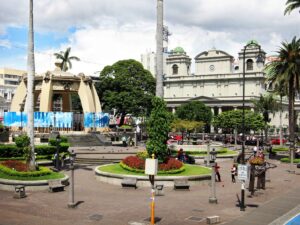 Costa Rica, the eighth largest North American country by population (5,043,084), is a presidential republic with a president as both head of state and head of government. The official language is Spanish and the country is 76% Catholic, 19% Protestant, and 4% Agnostic. The defense budget is $454 million and there are no active troops, rather 9,800 para-military style police. Natural resources are hydropower. The per capita GDP is $17,645. Compulsory education ages 4-16. Life expectancy female 81.9, male 76.3.
Costa Rica, the eighth largest North American country by population (5,043,084), is a presidential republic with a president as both head of state and head of government. The official language is Spanish and the country is 76% Catholic, 19% Protestant, and 4% Agnostic. The defense budget is $454 million and there are no active troops, rather 9,800 para-military style police. Natural resources are hydropower. The per capita GDP is $17,645. Compulsory education ages 4-16. Life expectancy female 81.9, male 76.3.
El Salvador, Capital City San Salvador
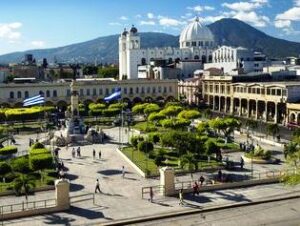 El Salvador, the sixth largest North American country by population (6,202,330), is a presidential republic, with a president as both head of state and head of government. The official language is Spanish and the country is 66% Catholic, 15% Independent, and 15% Protestant. The defense budget is $141 million and there are 24,500 active troops. Natural resources are hydropower, geothermal power, and petroleum. The per capita GDP is $8,317. Compulsory education ages 1-15. Life expectancy female 78.8, male 72.1.
El Salvador, the sixth largest North American country by population (6,202,330), is a presidential republic, with a president as both head of state and head of government. The official language is Spanish and the country is 66% Catholic, 15% Independent, and 15% Protestant. The defense budget is $141 million and there are 24,500 active troops. Natural resources are hydropower, geothermal power, and petroleum. The per capita GDP is $8,317. Compulsory education ages 1-15. Life expectancy female 78.8, male 72.1.
Guatemala, Capital City Guatemala City
 Guatemala, the fourth largest North American country by population (16,867,133), is a presidential republic with a president as both head of state and head of government. The official language is Spanish and the country is 67% Catholic, 19% Protestant, and 11% Independent. The defense budget is $256 million and there are 18,050 active troops. Natural resources are petroleum, rare woods, fish, and hydropower. The per capital GDP is $8,447. Compulsory education ages 6-15. Life expectancy female 74.2, male 70.1.
Guatemala, the fourth largest North American country by population (16,867,133), is a presidential republic with a president as both head of state and head of government. The official language is Spanish and the country is 67% Catholic, 19% Protestant, and 11% Independent. The defense budget is $256 million and there are 18,050 active troops. Natural resources are petroleum, rare woods, fish, and hydropower. The per capital GDP is $8,447. Compulsory education ages 6-15. Life expectancy female 74.2, male 70.1.
Honduras, Capital City Tegucigalpa
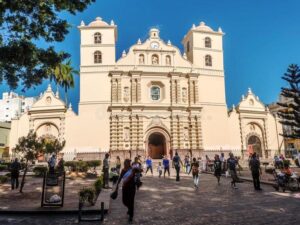 Honduras, the fifth largest North American country by population (9,325,005), is a presidential republic with a president as both head of state and head of government. The official language is Spanish and the country is 72% Catholic and 18% Protestant. The defense budget is $329 million and there are 14,950 active troops. Natural resources are timber, gold, coal, fish, hydropower. The per capita GDP is $5,130. Compulsory education ages 5-16. Life expectancy female 73.1, male 69.7.
Honduras, the fifth largest North American country by population (9,325,005), is a presidential republic with a president as both head of state and head of government. The official language is Spanish and the country is 72% Catholic and 18% Protestant. The defense budget is $329 million and there are 14,950 active troops. Natural resources are timber, gold, coal, fish, hydropower. The per capita GDP is $5,130. Compulsory education ages 5-16. Life expectancy female 73.1, male 69.7.
Mexico, Capital City Mexico City
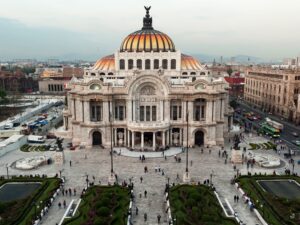 Mexico, the second largest North American country by population (127,318,112), is a federal presidential republic with a president as both head of state and head of government. The primary language is Spanish and the country is 86% Catholic, 10% Protestant, 3% Agnostic. The defense budget is $5.2 billion and there are 277,150 active troops. Natural resources are petroleum, various minerals, natural gas, timber. The per capita GDP is $19,969. Compulsory education ages 4-17. Life expectancy female 79.4, male 73.7.
Mexico, the second largest North American country by population (127,318,112), is a federal presidential republic with a president as both head of state and head of government. The primary language is Spanish and the country is 86% Catholic, 10% Protestant, 3% Agnostic. The defense budget is $5.2 billion and there are 277,150 active troops. Natural resources are petroleum, various minerals, natural gas, timber. The per capita GDP is $19,969. Compulsory education ages 4-17. Life expectancy female 79.4, male 73.7.
Nicaragua, Capital City Managua
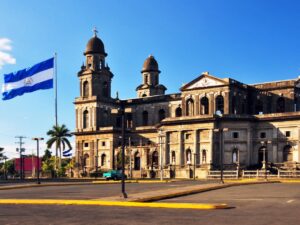 Nicaragua, the seventh largest North American country by population (6,144,442), is a presidential republic with a president as both head of state and head of government. The official language is Spanish and the country is 70% Catholic, 19% Protestant. The defense budget is $82 million and there are 12,000 active troops. Natural resources are gold, copper, lead, timber, fish. The per capita GDP is $5,524. Compulsory education ages 5-11. Life expectancy female 76.4, male 71.7.
Nicaragua, the seventh largest North American country by population (6,144,442), is a presidential republic with a president as both head of state and head of government. The official language is Spanish and the country is 70% Catholic, 19% Protestant. The defense budget is $82 million and there are 12,000 active troops. Natural resources are gold, copper, lead, timber, fish. The per capita GDP is $5,524. Compulsory education ages 5-11. Life expectancy female 76.4, male 71.7.
Panama, Capital City Panama City
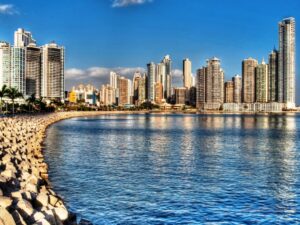 Panama, the ninth largest North American country by population (3,847,647), is a presidential republic with a president as both head of state and head of government. The official language is Spanish and the country is 74% Catholic, 10% Protestant, 4% Agnostic. The defense budget is $738 million and there are no armed forces but 26,000 paramilitary police. Natural resources are copper, mahogany, and shrimp. The per capita GDP is $25,509. Compulsory education ages 4-14. Life expectancy female 82.0, male 76.3.
Panama, the ninth largest North American country by population (3,847,647), is a presidential republic with a president as both head of state and head of government. The official language is Spanish and the country is 74% Catholic, 10% Protestant, 4% Agnostic. The defense budget is $738 million and there are no armed forces but 26,000 paramilitary police. Natural resources are copper, mahogany, and shrimp. The per capita GDP is $25,509. Compulsory education ages 4-14. Life expectancy female 82.0, male 76.3.
United States, Capital City Washington, DC
 United States, the largest North American country by population (331,883,986), is a constitutional federal republic with a president as both head of state and head of government. The primary languages are English and Spanish and the country is 27% Catholic, 24% Independent, 20% Protestant, 17% Agnostic. The defense budget is $643.3 billion and there are 1,359,450 active troops. Natural resources are coal, various minerals, petroleum, timber. The per capita GDP is $62,641. Compulsory education ages 6-17. Life expectancy female 82.4, male 78.0.
United States, the largest North American country by population (331,883,986), is a constitutional federal republic with a president as both head of state and head of government. The primary languages are English and Spanish and the country is 27% Catholic, 24% Independent, 20% Protestant, 17% Agnostic. The defense budget is $643.3 billion and there are 1,359,450 active troops. Natural resources are coal, various minerals, petroleum, timber. The per capita GDP is $62,641. Compulsory education ages 6-17. Life expectancy female 82.4, male 78.0.
Resource: The World Almanac and Book of Facts 2020
» posted on Friday, September 4th, 2020 by Linda Lou Burton
Know Your Neighbors – North America
September 4, 2020, Linda Lou Burton posting from Little Rock, Arkansas – Do you know your geography? There are ten countries in North America – I keep up with them by memorizing them alphabetically.
- Belize
- Canada
- Costa Rica
- El Salvador
- Guatemala
- Honduras
- Mexico
- Nicaragua
- Panama
- United States
Where do the most people live?
- United States 331,883,986
- Mexico 127,318,112
- Canada 36,136,376
- Guatemala 16,867,133
- Honduras 9,325,005
- El Salvador 6,202,330
- Nicaragua 6,144,442
- Costa Rica 5,043,084
- Panama 3,847,647
- Belize 392,771
If you had to walk across it, which county would take the longest? Which is largest in square miles?
- Canada 3,855,103
- United States 3,796,742
- Mexico 758,449
- Nicaragua 50,336
- Honduras 43,278
- Guatemala 42,042
- Panama 29,120
- Costa Rica 19,730
- Belize 8,867
- El Salvador 8,124
Which country has the highest percentage of internet users? Most technologically inclined?
- Canada 91.0%
- United States 87.3%
- Costa Rica 74.1%
- Mexico 65.8%
- Guatemala 65.0%
- Panama 57.9%
- Belize 47.1%
- El Salvador 33.8%
- Honduras 31.7%
- Nicaragua 27.9%
Which country has the highest literacy rate? Percent of population able to read and write?
- Canada 99.0%
- United States 99.0%
- Costa Rica 97.8%
- Panama 95.0%
- Mexico 94.9%
- Honduras 89.0%
- El Salvador 88.5%
- Nicaragua 82.8%
- Guatemala 81.5%
- Belize 79.1%
Which country has the highest population density? How many people are there per square mile? Close to each other or lots of breathing space?
- El Salvador 763
- Guatemala 401
- Costa Rica 256
- Honduras 215
- Mexico 168
- Panama 132
- Nicaragua 122
- United States 87
- Belize 44
- Canada 9
Which country has had the most confirmed DEATHS from COVID19 in 2020 to date?
- United States 185,687
- Mexico 66,329
- Canada 9,141
- Guatemala 2,825
- Panama 2,046
- Honduras 1,954
- El Salvador 744
- Costa Rica 460
- Nicaragua 141
- Belize 13
Which country has had the most confirmed CASES of COVID19 reported in 2020 to date?
- United States 6,095,007
- Mexico 616,894
- Canada 130,493
- Panama 94,914
- Guatemala 77,040
- Honduras 63,158
- Costa Rica 44,458
- El Salvador 26,099
- Nicaragua 3,773
- Belize 1,118
Which county has the highest percent of their population diagnosed with COVID19 in 2020 to date?
- Panama 2.47%
- United States 1.84%
- Costa Rica 0.88%
- Honduras 0.68%
- Mexico 0.48%
- Guatemala 0.46%
- El Salvador 0.42%
- Canada 0.36%
- Belize 0.28%
- Nicaragua 0.06%



